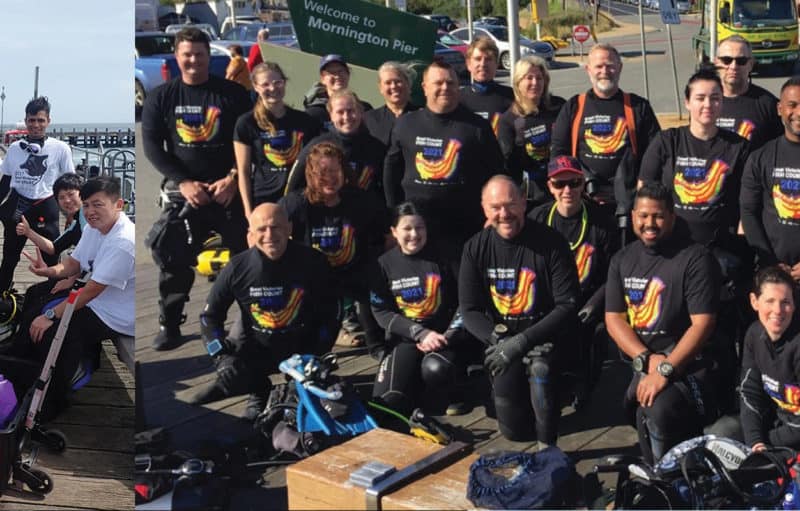PARK WATCH Article November 2022 |
Q&A: Catherine Watson from Save Western Port Woodlands
1. Can you tell us about a memorable experience of nature from your childhood or younger years.
I had no interest in nature as a child. I lived in suburbia. My most memorable experiences involved moths because they terrified me if they got into my bedroom at night. I grew up in New Zealand so fortunately I didn’t encounter Huntsman spiders or snakes.
2. Do you recall any events, people or places that influenced your love of nature? What was their influence?
When I came to Australia I lived in Collingwood for the first 20 years and the only nature I knew was human nature. Then my partner and I bought an old cottage in Wonthaggi next to a bush reserve. I noticed how much my neighbour noticed – she would point out tiny Pardalotes burrowing in a bank, Mayfly orchids, things I would never have seen. One day she even saw a Koala because she was looking up! I started to see more – though at first only the very obvious stuff, like Banksias and Laughing Kookaburras.
3. What was your earliest experience of the Western Port Woodlands?
I was like everybody. For many years my only experience of the woodlands was driving past them. Occasionally, I would wonder what was in the forest on the ridge but there is no obvious way of getting in, no indication that you are passing conservation reserves. I heard stories that two-metre lizards had been seen in The Gurdies. Of course, I didn’t believe them. A friend of mine lives in The Gurdies and she took me for a walk. It actually took me a while to ‘get’ the woodlands.
It’s not magnificent, like a Mountain Ash forest. The trees are quite small. It’s the muted grey and olive green of Messmate and Peppermint, with space between so you get the long view. It welcomes you in. It is very tranquil – apart from the sound of mining and sand trucks.
The great irony is that the Western Port Woodlands weren’t cleared because it’s poor farming country as it’s on sand. It’s also a very biodiverse environment because of the sand. The lack of nutrients produces the grass trees, the orchids, the wildflowers, the fungi. And now the woodlands are at risk because the state wants the sand for Melbourne’s Big Build.
Oh, and a couple of weeks ago I saw my first Lace Monitor – just a youngster, about 1.5 metres long.
4. What drew you to stand up for the Woodlands?
I got dragged into it. I publish an online magazine called the Bass Coast Post. I published a couple of articles about the Holden Proving Ground, which GMH had put on the market. A campaign started to try to persuade the State Government to buy the proving ground as habitat. It’s almost 1000 hectares of old vegetation with a vermin-proof fence around it.
We only gradually realised the entire forest corridor was under threat from a surge in sand mining. There were already 10 sand mines, including five in nature conservation reserves, with more on the way. Our focus changed from saving the proving ground to saving the woodlands.
You have to understand there was no Western Port Woodlands as such at that stage. One of the real achievements of our campaign has been naming it so it is now seen as a whole, a 20km forest corridor (with some gaps) stretching from Lang Lang to Bass. Recently I have even seen the name Western Port Woodlands used in ministerial correspondence!
5. How long have you been involved in caring for Woodlands?
Our steering committee met for the first time in early 2020, just as the pandemic started.
But this is the second iteration of the woodland campaign. There was a tireless community campaign back in the mid-1990s, which culminated in the only contract ever signed between the Government, the community and the sand mining industry. It permitted sand mining in less environmentally sensitive areas but ensured a network of conservation reserves would provide habitat and biolinks for threatened species along the corridor.
Unfortunately, once adopted, it was virtually ignored by government and industry. Which shows the community must remain eternally vigilant.
6. If we could all do one thing to care for the Western Port Woodlands, what would you recommend we do?
Abolish the offset bullshit con job! Don’t clear significant vegetation for mining, industry or residential development. End of story.
7. What would a healthy, protected and respected Western Port Woodlands look like to you in 5-10 years?
In 2035 the woodlands is a national park co-managed by the Bunurong Land Council and Parks Victoria for the benefit of all Victorians.
By then, of course, it’s known by a name chosen by the traditional owners to reflect their many thousands of years as custodians. Parks Victoria has enough staff to tackle Pittosporum and Agapanthus and maintain the tracks.
The last sand mines have closed and are being rehabilitated. The mining companies were compensated with land swaps and leases on cleared farmland in Cardinia Shire, and the sand is freighted to a Melbourne hub by rail. The monster sand trucks are gone.
The State Government did buy the old proving ground. The front section is used to road test locally-made EVs. The back section is now used in a recovery program for Southern Brown Bandicoots, Leadbeater’s Possums and Strzelecki Koalas. Numbers are booming.
Learn more about Save Western Port Woodlands
Download or read the Western Port Woodlands report
Did you like reading this article? You can read the latest full edition of Park Watch magazine online.
Want to be kept up to date about this and other nature issues in Victoria? Subscribe to our email updates.
You can also receive our print magazine Park Watch four times a year by becoming a member. Find out more.
